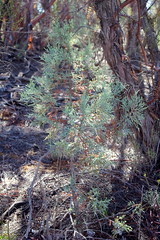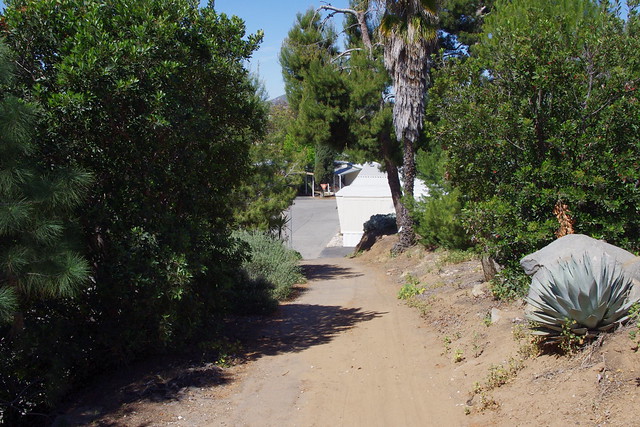Even when I have no Place to put them
 |
| Alligator Juniper in Anza CA |
 |
| Photo - Tom Peck |
I wrote Robyn back about something else I had collected up there another time and that was a Huachuca Agave. It's amazing to be up so high in a Sky Island forest as they are called in Southern Arizona and find Agaves inside the old growth Pine/Oak Forest understory. You just don't associate in your mind such things coming together. And yet there they are. This tiny agave I took was actually a pup I had separated from the mother plant was about the size of the palm of my hand. I planted it under the New Mexico Locusts I had collected years previous on a visit to Ruidoso, New Mexico. The Agave grew quite well, but when I sold the property, I just couldn't part with it. Hence I brought it down to my Mum's house in El Cajon CA, but I didn't have a place for it, so I took it to my place of work and replanted it on the hill.
I brought the plant back to my place in Anza and planted it under a fairly moist area some Redshanks of all plants. But as you can see from the photo by Tom Sykes, plants you do not normally associate together do quite often form strange bedfellows there in the Huachuca Mountains. The plant actually grew into several and once again, when I moved I took them with me to El Cajon CA. I placed them in my mum's newly created planter I built. They did wonderfully for a year until my Mum's stupid Wienerdog (Dachshund) which is a tweaked disturbed hound with an obsession for fetching and if you didn't continually throw her toy, she would go and destroy what plants she noticed you would so lovely attend to. My sister's dog (a Border Collie) was also another one of those insane fetch dogs. I spent over a month creating a kool native plant scene and installed a nice lawn at her brand purchased tract home in Lakeside CA in 2001. This dog was jealous if you refused to fetch and would deliberately tear out plants in retaliation. And that's exactly what happened, it totally trashed her yard. I literally found both of those dogs extremely irritating. What's even more frustrating than that is the inability to move the owner's of such dogs into action to put a stop to it. As a landscape supervisor in San Diego for that property management company, I had developed a reputation for hating the client's dogs. That was untrue, what I disliked was an owner's unwillingness to control and prevent their dog from crapping on our public lawns, especially since the Human owner or master is the main one who has power and authority to make the dog behave. That never happened. Needless to say, those original Huachuca Coral Bells no longer exist at Mum's place. *sigh*
On another note, I also mentioned another tree for which I had taken back to California from Arizona. This was the Apache Pine I mentioned yesterday in the Alligator Juniper post. I did however, purchase it from James Koweek, who in turn actually did climb the Huachucas and collect the seedlings in the wild because he could never find viable seed or had trouble germinating them if he did acquire it, I forget exactly what he said. But I did have a Nursery receipt when I crossed that California/Arizona border at the Blythe Agricultural Station. But it didn't stop that officer from taking that plant out of the container and messing with the root ball which I thought would have done it in for sure, which was no doubt what he wanted as well. Fortunately the Apache Pine and me had other ideas. Apaches have always been hard to kill. *smile* Sadly, as I mentioned in that post yesterday, a tree trimmer who rented my old place cut it down for a place to park his equipment. Whatever. But just to let folks interested in landscaping in Southern California know, the Apache Pine does extremely well in landscape or garden situations in the interior valleys which are often very hot and dry. Take for an example, the Wild Animal Safari Park south of Escondido in the San Pasqual Valley. I took photos there back in 2007 when we last visited. My favourite place in all that Park hasn't always been around the African or Asian animals, though they are kool. It's the native plant garden and desert plant garden areas.
In so many ways, this remarkable Pine is similar to Canary Island Pine and would make an excellent replacement. But unfortunately you just don't find them anywhere in any of the local So-Cal Nurseries. Most of the So-Cal Native Plant Nurseries won't touch anything out of state, well, unless of course it's Baja. But I have to admit that it's ability to survive and thrive down along the interior valleys of Southern California does impress me because even the native Jeffrey and Ponderosa Pines up in the local mountains will not do as well. They are both very smog sensitive and demand a cooler environment in which the local high elevations offer.
-
 |
| Photo Mine |
This is from our trip to the Sonoran Desert Museum in Tucson AZ & the Huachuca Agave display
 |
| Photo Mine |
And there is it. Even has pups on the other side of it. I actually acquired it back in 1996. It's a long way away from it's form birth place high forested shady elevation in another state to a fun sun much hotter southern exposure in El Cajon California.Another plant I had collected from up there in the Huachucas Mtns was a beautiful native Coral Bells variety with exceptional deep lipstick red colour. So many I had seen back over a decade ago were many with pale red or pink flowers in Nurseries, so a deep bright red was an eye catcher. Unfortunately it was along the side of a dangerous rock cliff face which also had slippery seep or cienega which hydrated the plants. I actually had to scale up this rock face a bit and reach over from the side and pluck out a tiny specimen. Coral Bells will often form several bunches which can be separated to form and grow newer plants. For people unfamiliar with Carr Canyon Falls and where I plucked this plant from, here is an illustrated example to the right and above. This is a dangerous area and it notoriously known for many deaths by people taking *cough-cough* chances like me. So please don't do this. I no longer take such stupid idiot chances, although it doesn't mean I don't think about doing such at times. Fortunately now I simply cop out.
 |
| Credit: Tom and Carol Sykes |
 |
| Apache Pine |
 |
| photo: Mine |
 |
| Photo Credit: Mine 2011 |
This is a closeup of one of the branches of an Apache Pine near the cage enclosure of the Thick Billed Parrot which is a native to southern Arizona. In some ways their cones are similar to Canary Island, but just a bit more round and wider.
 |
| Photo: Mine |
This shot of the Apache Pines is taken next to the green & red Thick-Billed Parrot enclosure. It's appropriate since both the parrot and the pine share the same habitat in Arizona. Clearly though, anyone can see the tree does rather well at these hotter drier locations where Jeffrey, Ponderosa and other high elevation So-Cal natives would and do often fail. I really hope one day someone out there gets a clue and decides to collect enough seed to start promoting to the public the potential value of Apache Pine in California Urban Landscapes. If you don't believe it can be done, just visit the San Diego Safari Park and Native Plants collection display.I don't know if my collecting days are finished or what. I don't have the resources for establishment anymore. Or even a favourable climate for that matter. But I still have this inner drive to collect seed and small plant specimens. So I guess I'll always have ScrubJay Syndrome, but I think I can live with it. As a result, I have learned so much over the years with this quirky handicap.
-

I collect rocks and this trip I came back with two pines cones from the Sierras. I don't come back with plants, however. Hey, we'll be in Arizona in August...up on the Mogollon Rim.
ReplyDeleteThat sounds fun. Especially considering the Monsoon Season will be upon you.
Delete